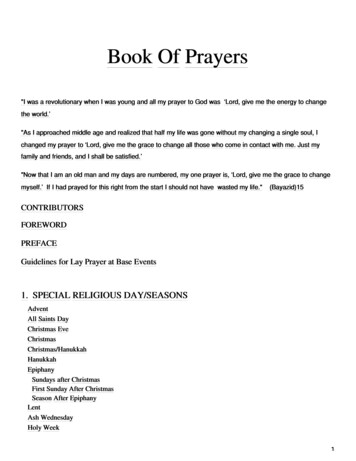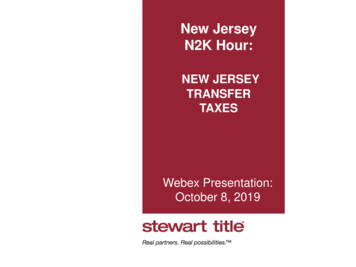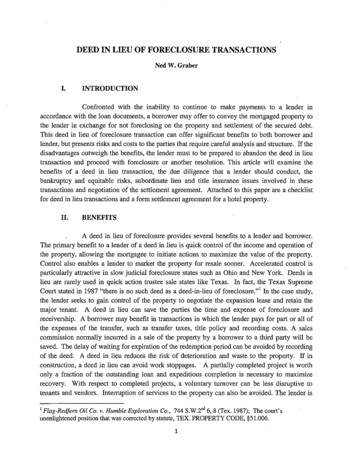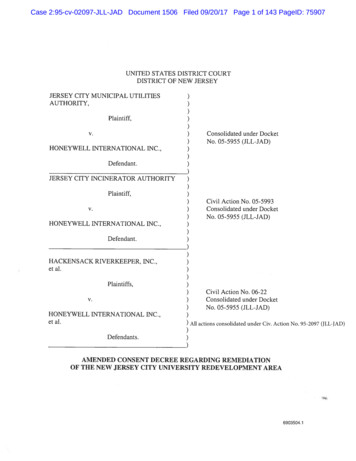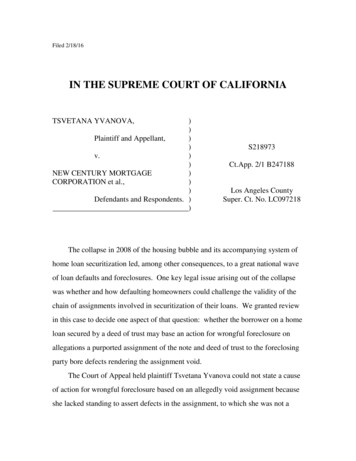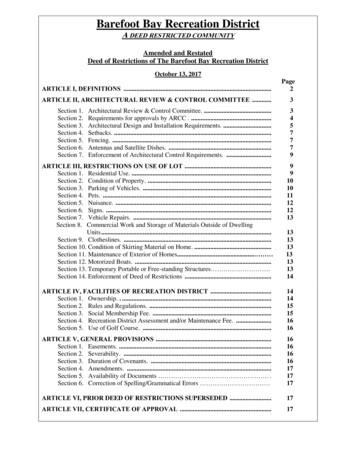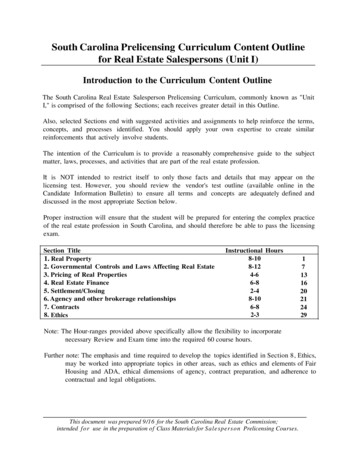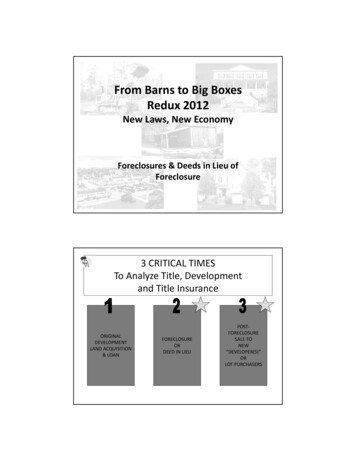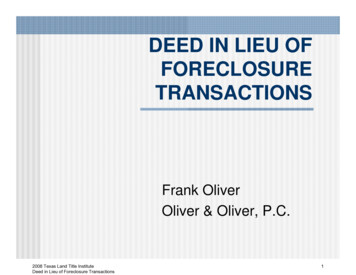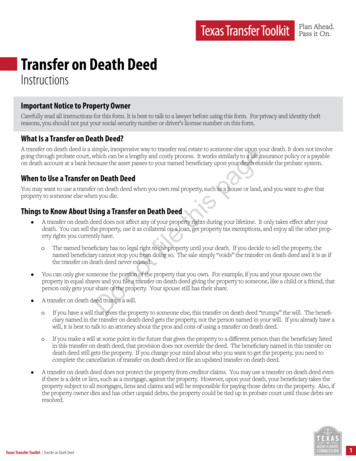
Transcription
Transfer on Death DeedInstructionsImportant Notice to Property OwnerCarefully read all instructions for this form. It is best to talk to a lawyer before using this form. For privacy and identity theftreasons, you should not put your social security number or driver’s license number on this form.What Is a Transfer on Death Deed?pageA transfer on death deed is a simple, inexpensive way to transfer real estate to someone else upon your death. It does not involvegoing through probate court, which can be a lengthy and costly process. It works similarly to a life insurance policy or a payableon death account at a bank because the asset passes to your named beneficiary upon your death outside the probate system.When to Use a Transfer on Death DeedisYou may want to use a transfer on death deed when you own real property, such as a house or land, and you want to give thatproperty to someone else when you die.A transfer on death deed does not affect any of your property rights during your lifetime. It only takes effect after yourdeath. You can sell the property, use it as collateral on a loan, get property tax exemptions, and enjoy all the other property rights you currently have.The named beneficiary has no legal right to the property until your death. If you decide to sell the property, thenamed beneficiary cannot stop you from doing so. The sale simply “voids” the transfer on death deed and it is as ifthe transfer on death deed never existed.notfɐɐile thThings to Know About Using a Transfer on Death DeedYou can only give someone the portion of the property that you own. For example, if you and your spouse own theproperty in equal shares and you file a transfer on death deed giving the property to someone, like a child or a friend, thatperson only gets your share of the property. Your spouse still has their share. A transfer on death deed trumps a will. Do ɐɐIf you have a will that gives the property to someone else, this transfer on death deed “trumps” the will. The beneficiary named in the transfer on death deed gets the property, not the person named in your will. If you already have awill, it is best to talk to an attorney about the pros and cons of using a transfer on death deed.ɐɐIf you make a will at some point in the future that gives the property to a different person than the beneficiary listedin this transfer on death deed, that provision does not override the deed. The beneficiary named in this transfer ondeath deed still gets the property. If you change your mind about who you want to get the property, you need tocomplete the cancellation of transfer on death deed or file an updated transfer on death deed.A transfer on death deed does not protect the property from creditor claims. You may use a transfer on death deed evenif there is a debt or lien, such as a mortgage, against the property. However, upon your death, your beneficiary takes theproperty subject to all mortgages, liens and claims and will be responsible for paying those debts on the property. Also, ifthe property owner dies and has other unpaid debts, the property could be tied up in probate court until those debts areresolved.Texas Transfer Toolkit Transfer on Death Deed1
The transfer on death deed beneficiary must survive you by at least 120 hours. If not, the property is treated as if thetransfer on death deed did not exist. A transfer on death deed cannot be created by a person acting under a property owner’s power of attorney, however, thatperson can cancel the transfer on death deed.Required Must Sign in Front of a Notary: Do not sign or date the transfer on death deed until you are standing in front of a notarypublic. Must Record Transfer on Death Deed Before Your Death: You must record (file) this deed before your death with thecounty clerk where the property is located or it will not be effective.1. Property Owner (Transferor) Making this Deed: Enter your first, middle (if any), and last name, along with your mailingaddress. Write your name exactly as it appears on the deed you received when you became an owner of the property. If younow go by a different name, write your name as listed on the deed, followed by AKA (also known as) and your current name.If more than one person owns the property, each person must do this.is3. Address of the Property: Enter the physical address of the property.page2. Legal Description of the Property: Enter the legal description of the property, which is different from the mailing or physicaladdress of the property. This information is on the deed you received when you became an owner of the property and is alsoavailable at the county clerk’s office in the county where the property is located. Do NOT use the legal description listed onyour property tax bill because it is usually incomplete. IT IS VERY IMPORTANT THAT THIS INFORMATION IS CORRECT.If you are not absolutely sure, talk to a lawyer.th4. Primary and Alternate Beneficiaries: You must check the box for A, B, or C. Check ONLY ONE box and fill in the blanks inthat section.Fill out Selection A if you are married and you and your spouse own the property together. Fill out Selection B if you are married and you own all or part of the property by yourself (your spouse doesn’t own anypart of it) AND you want your spouse to get your share of the property. Fill out Selection C if either you are not married OR if you are married and do not want your share of the property to goto your spouse.notfile Each selection (A, B, or C) has three parts:Primary Beneficiary: A “beneficiary” is the person who will own the property when you die. The primary beneficiaryis the first person you want to own the property. You can, but are not required to, name more than one person asprimary beneficiary.2.Alternate Beneficiary or Beneficiaries: The alternate beneficiary or beneficiaries are the people you want to own theproperty if the primary beneficiary or beneficiaries die before you do.3.Transfer on Death: This section tells how you want your property to pass if all your beneficiaries die before you.Do1.ɐɐɐɐFor Selection A and B: Initial option (a) if you want the alternate beneficiary or beneficiaries’ living children, grandchildren, orgreat-grandchildren to get your share of the property if that beneficiary dies before you do. Initial option (b) if you DO NOT want the alternate beneficiary or beneficiaries’ children, grandchildren, orgreat-grandchildren to get your share of the property if that beneficiary dies before you do.For Selection C, section:A. If at Least One Primary Beneficiary Survives Me: If you name more than one primary beneficiary, thissection tells what you want to do with your share of the property if one or more primary beneficiaries diebefore you, but one or more are still living.Texas Transfer Toolkit Transfer on Death Deed2
Initial option (a) if you want the deceased primary beneficiary or beneficiaries’ share to go to thatperson’s living children, grandchildren, or great-grandchildren. Initial option (b) if you DO NOT want the deceased primary beneficiary or beneficiaries’ share to go tothat person’s children, grandchildren, or great-grandchildren. This share will be split among the livingprimary beneficiaries.B. If NO Primary Beneficiary Survives Me (dies after I do): If my primary beneficiary is my child (or otherdescendant) or my brother or sister (or other descendant of either of my parents) AND all primary beneficiaries die before I do, I grant and convey (give) my share to (choose by writing your initials in ONE blankONLY): Initial option (a) if you want the deceased primary beneficiary or beneficiaries’ share to go to thatperson’s living children, grandchildren, or great-grandchildren. Initial option (b) if you DO NOT want the deceased primary beneficiary or beneficiaries’ share to go tothat person’s children, grandchildren, or great-grandchildren. The alternate beneficiary or beneficiarieswill get the share.pageC. If an Alternative Beneficiary Does Not Survive Me: If all your primary beneficiaries and one or more alternate beneficiaries die before you do, this section tells what you want to do with your share of the property.Initial option (a) if you want the deceased alternate beneficiary or beneficiaries’ shares to go to thatperson’s children, grandchildren, or great-grandchildren. Initial option (b) if you DO NOT want the deceased alternate beneficiary or beneficiaries’ shares to goto that person’s children, grandchildren, or great-grandchildren. This transfer on death deed will becanceled if no primary or alternate beneficiaries are alive when you die.is thIf you do not initial any section, it will be assumed you chose option (a).ile5. Signature of Property Owner: This deed must be signed before a notary. Do not sign your name or enter the date until youare in front of a notary. If two people own the property, both need to sign before a notary.tf6. Acknowledgement: You do not need to fill out anything in this box. The notary will fill it out.no7. “After Recording, Return to” Section: Fill in the property owner’s name and address here. Once the transfer on death deedhas been recorded, it will be returned to the property owner with the specific information (the volume, page number, and/or deed number) on where the deed has been recorded in the county clerk’s office so that it can be located later. Keep thetransfer on death deed in a safe place.o8. File the Deed (NOT These Instructions) in the County Clerk’s Office:Bring Original and One Copy: Bring the original and at least one copy of the complete and notarized transfer on deathdeed to the County Clerk’s office in the county where the property is located. Bring Personal Identification: The county clerk may require you to show personal identification before you file thisdocument. Bring Money: The County Clerk will charge a fee to file the transfer on death deed, which is typically a per page fee.Many County Clerks do not accept checks. You may want to call the County Clerk’s office and find out how much thecharge will be and whether they accept checks before you go. Then file the original and ask them to return a copy of theoriginal with the recording information on it to the owner. Do Not File the Instructions: If you file the instructions, it may cause confusion and will also cost you more money.D Texas Transfer Toolkit Transfer on Death Deed3
Transfer on Death DeedIMPORTANT NOTICE TO PROPERTY OWNER: Carefully read all instructions for this form. It is always best to talkto a lawyer before using this form. For privacy reasons, do not put your social security number or driver’s licensenumber on this form. Do not file these instructions.REQUIRED: Must Sign and Date Transfer on Death Deed In Front of a Notary. Must Record Transfer on Death Deed Before Your Death: You must record (file) this deed before yourdeath with the county clerk where the property is located or it will not be effective.1. Property Owner(s) (Transferors) Making this Deed. Enter your first, middle (if any), and last name here, along withyour mailing address. If more than one person owns the property, all owners must list this information.Property Owner’s Printed NameSecond Owner’s Printed Name (If Applicable)Mailing Address:Mailing Address:Address 1Address 2CityStateZipAddress 1Address 2CityStateZip2. Legal Description of the Property. The legal description is not the mailing or physical address of the property. Thelegal description is listed on the deed to the property, which you should have gotten when you became an owner. Thisinformation may also be available at the county clerk’s office in the county where the property is located. Do NOT usethe legal description listed on your property tax bill because it may be incorrect. IT IS VERY IMPORTANT THAT THISINFORMATION IS CORRECT. If you are not absolutely sure, talk to a lawyer.Print legal description of the property.3. Address of the Property (if any). This is the physical address of the property. Include county.AddressCityCountyStateZip4. Primary and Alternate Beneficiaries. MUST CHECK AND COMPLETE A, B, OR C (Check ONE and ONLY ONE): A “beneficiary” is the person who you want to own the property when you die.Section A: Fill out this section if you are married, and you and your spouse own the property together, and youwant your spouse to own the property when you die.Section B: Fill out this section if you are married and you own the property by yourself – your spouse doesn’t ownany part of it – and you want your spouse to own the property when you die.Section C: Fill out this section in all other situations. See #4 in the detailed instructions to this form.Revocable Transfer on Death Deed, July 2019Page 1
Transfer on Death Deed A.Both Spouses Own the Property and Want to Leave to Surviving Spouse: Fill out this section if you aremarried, and you and your spouse own the property together, and you want your spouse to own the property whenyou die. Both spouses must sign the transfer on death deed.1) Primary Beneficiary is Surviving Spouse: The owners of this property are married to each other andare both signing this deed. If one of us dies and the other is living, the living spouse will be the soleowner of the property.2) Alternate Beneficiary or Beneficiaries: Enter the first, middle (if any), and last name of each person youwant to get the property when both you and your spouse have died. This person(s) will be named the“beneficiary(ies).” You may list more than two beneficiaries by attaching a page with their name and mailingaddress.When we are both deceased, we want the following person(s) to own our property. This person(s)may or may not be our child, descendant, or a member of our family. If more than onealternate beneficiary is listed, they will own the property in equal shares.3)Alternate Beneficiary Print NameSecond Alternate Beneficiary (Optional) Print NameMailing Address:Mailing Address:Address 1Address 1Address 2Address 2CityCityStateZipStateZipTransfer on Death: If the alternate beneficiary is your child (or other descendant) or your brother or sister(or other descendant of either of your parents), you must choose an option below.At my death, I convey to (give) the primary beneficiary my interest in the property to have and holdforever. If my primary beneficiary does not survive me (dies before I do), I grant and convey (give)my interest in the property to my alternate beneficiary. If my alternate beneficiary is my child (orother descendant) or my brother or sister (or other descendant of either of my parents) AND analternate beneficiary dies before I do, I grant and convey (give) my share to any living alternatebeneficiary AND (choose by writing your initials in ONE blank ONLY):(a) the deceased alternate beneficiary’s share will pass to his/her surviving children or otherdescendants.(b) no one else. I do not want the deceased alternate beneficiary’s surviving children or otherdescendants to have a share of the property. If no primary or alternate beneficiary is alivewhen I die, this deed is canceled and has no force and effect, as if it had never beenexecuted.Revocable Transfer on Death Deed, July 2019Page 2
Transfer on Death Deed B. Only One Spouse Owns the Property:Fill out this section if you are married and you own all or part of theproperty by yourself – your spouse doesn’t own any part of it – and you want your spouse to own the propertywhen you die.1) Primary Beneficiary: I designate my spouse as the primary beneficiary if I die before my spouse:Spouse’s Printed Name:Spouse’s Mailing Address:Address 1Address 2CityStateZip2) Alternate Beneficiary or Beneficiaries: Enter the first, middle (if any), and last name of each person youwant to get the property if your spouse dies before you. You may list more than two alternate beneficiaries byattaching a page with their name and mailing address.If my spouse dies before me, I want the following person(s) to own my property when I die. Thisperson(s) may or may not be my child, descendant, or a member of my family. If more than onealternate beneficiary is listed, they will own the property in equal shares.Alternate Beneficiary Print NameSecond Alternate Beneficiary (Optional) Print NameMailing Address:Mailing Address:Address 1Address 1Address 2Address 2CityCityStateZipStateZip3) Transfer on Death: If the alternate beneficiary is your child (or other descendant) or your brother or sister (orother descendant of either of your parents), you must choose an option below.At my death, I convey to (give) the primary beneficiary my interest in the property to have and holdforever. If my primary beneficiary does not survive me (dies before I do), I grant and convey (give)my interest in the property to my alternate beneficiary. If my alternate beneficiary is my child (orother descendant) or my brother or sister (or other descendant of either of my parents) AND analternate beneficiary dies before I do, I grant and convey (give) my share to any living alternatebeneficiary AND (choose by writing your initials in ONE blank ONLY):(a) the deceased alternate beneficiary’s share will pass to his/her surviving children or otherdescendants.(b) no one else. I do not want the deceased alternate beneficiary’s surviving children or otherdescendants to have a share of the property. If no primary or alternate beneficiary is alivewhen I die, this deed is canceled and has no force and effect, as if it had never beenexecuted.Revocable Transfer on Death Deed, July 2019Page 3
Transfer on Death Deed C.Other: Fill out this section if neither section A or B apply to you, including if you are married and you do notwant your share of the property to go to your spouse.1) Primary Beneficiary: Enter the first, middle (if any), and last name of each person you want to get theproperty when you die. This person or people will be named the “beneficiary”. You may list more than twoprimary beneficiaries by attaching a page with their name and mailing address.I want the following person(s) to own my property. This person(s) may or may not be my child,descendant, or a member of my family. If more than one primary beneficiary is listed, they will ownthe property in equal shares.Primary Beneficiary Print NameSecond Primary Beneficiary (Optional) Print NameMailing Address:Mailing Address:Address 1Address 1Address 2Address 2CityCityStateZipStateZip2) Alternate Beneficiary or Beneficiaries: Enter the first, middle (if any), and last name of each person youwant to get the property if all primary beneficiaries die before you. You may list more than two alternatebeneficiaries by attaching a page with their name and mailing address.If all the primary beneficiary or beneficiaries die before me, I want the following person(s) to ownmy property. If more than one alternate beneficiary is listed, they will own the property in equalshares:Alternate BeneficiarySecond Alternate Beneficiary (Optional)Print NamePrint NameMailing Address:Mailing Address:Address 1Address 1Address 2Address 2CityCityStateZipStateZip3) Transfer on Death: If the primary or alternate beneficiary is your child (or other descendant) or your brotheror sister (or other descendant of either of your parents), you must choose an option from each A and B below.At my death, I convey to (give) the primary beneficiary my interest in the property to have and holdforever.Revocable Transfer on Death Deed, July 2019Page 4
Transfer on Death DeedA) If at least one Primary Beneficiary Survives Me (dies after I do):If my primary beneficiary is my child (or other descendant) or my brother or sister (or otherdescendant of either of my parents) AND a primary beneficiary dies before I do, I grant andconvey (give) my share to any living primary beneficiary AND (choose by writing your initials inONE blank ONLY):(a) the deceased primary beneficiary’s share will pass to his/her surviving children orother descendants.(b) no one else. I do not want the deceased primary beneficiary’s surviving children orother descendants to have a share of the property.B) If NO Primary Beneficiary Survives Me (dies after I do):If my primary beneficiary is my child (or other descendant) or my brother or sister (or otherdescendant of either of my parents) AND all primary beneficiaries die before I do, I grant andconvey (give) my share to (choose by writing your initials in ONE blank ONLY):(a) the deceased primary beneficiary’s share will pass to his/her surviving children orother descendants.(b) the alternate beneficiary or beneficiaries. I do not want the deceased primarybeneficiary’s surviving children or other descendants to have a share of the property. If noprimary beneficiary is alive when I die and I did not choose an alternate beneficiary, this deed iscanceled and has no force and effect, as if it had never been executed.C) If an Alternate Beneficiary Does Not Survive Me (dies before I do):If my alternate beneficiary is my child (or other descendant) or my brother or sister (or otherdescendant of either of my parents) AND an alternate beneficiary dies before I do, I grant andconvey (give) my share to any living alternate beneficiary AND (choose by writing your initials inONE blank ONLY):(a) the deceased alternate beneficiary’s share will pass to his/her surviving childrenor other descendants.(b) no one else. I do not want the deceased alternate beneficiary’s survivingchildren or other descendants to have a share of the property. If no primary or alternatebeneficiary is alive when I die, this deed is canceled and has no force and effect, as if it had neverbeen executed.Revocable Transfer on Death Deed, July 2019Page 5
Transfer on Death Deed5. Signature of Property Owner(s) Making this Deed: Do not sign or date below until you are in front of a notarypublic.Owner’s SignatureSecond Owner’s Signature (If Applicable)DateDateFOR NOTARY TO COMPLETEAcknowledgementSTATE OFCOUNTY OFThis instrument was acknowledged before me on the day of , 20 , by.Notary Public’s SignatureAfter recording, please return to:Owner’s Name and Mailing AddressNameAddress 1Address 2CityStateRevocable Transfer on Death Deed, July 2019ZipPage 6
Bring Original and One Copy: Bring the original and at least one copy of the complete and notarized transfer on death deed to the County Clerk's office in the county where the property is located. Bring Personal Identification: The county clerk may require you to show personal identification before you file this document.
